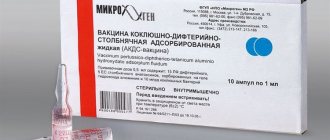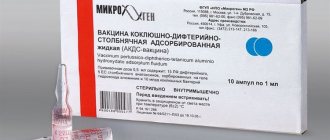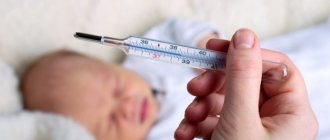Young children often experience a reaction to vaccinations. The area where the vaccine was administered may turn red. A tumor often appears. Some guys develop small rashes on the skin after the injection, and the redness is so great that it’s scary in appearance. All this is due to a completely natural reaction of the body to the administered drug. The situation is normal, so no need to worry. Mom just needs to take some measures, but not worry or scare the baby. You should remember the signs that are quite natural after vaccination.
What causes
Immunity protects the child’s body from various diseases. In the first year of life, the antibodies inherited from the mother still work. Then you need to build your own immunity. They do this with the help of vaccinations against various diseases.
Immunization with vaccines causes the body to produce antibodies to certain viruses and bacteria. There are several types of vaccines: live and attenuated, killed, chemical, monovaccines, toxoids. After the drug is introduced into the body, certain reactions occur that do not last long and usually do not cause any complications.
Doctors distinguish three types of post-vaccination reactions: mild, moderate and complications. The first two types are common and are considered the norm. In addition to general reactions, such as drowsiness, weakness, high temperature, there are local ones - thickening and redness at the injection site. Most often, such symptoms appear after vaccinations against hepatitis, DTP, ADS, since the drugs contain substances that deliberately provoke inflammation. Thanks to this, the immune response is more pronounced, and as many cells as possible are involved in the production of antibodies.
Why is DTP vaccine needed?
Whooping cough, diphtheria and tetanus are considered very serious diseases. Moreover, they are dangerous not so much by the disease itself, but by the consequences after it. Whooping cough, for example, leads to pneumonia or inflammation of the brain.
What distinguishes these diseases from many others is that complications are caused not so much by microbes as by the toxins they produce. Therefore, the body needs to create immunity against the toxin. This is what the DTP vaccine is designed to do.
Any vaccination causes a serious restructuring of the body associated with a restructuring of the immune system.
Side effects
Redness and swelling most often occur after using inactivated vaccines, on the leg or shoulder (depending on where the injection was given). Symptoms usually last for a couple of days. According to statistics, redness or lumps appear in every fourth child, so there is no reason to worry. In addition, with each subsequent vaccination or revaccination, such manifestations become brighter, since immunity to certain diseases is finally formed.
After DTP vaccination, the compaction and redness are especially great and can reach 80 mm. Occasionally, cones exceed this diameter, but this only happens if contraindications are not observed. This reaction goes away on its own within 3-5 days. If the vaccination site is not just swollen, but general complications are mixed in, this is a reason to consult a doctor. A similar reaction also occurs to BCG, when a crust develops at the injection site - this is absolutely normal.
Possible reactions of a child to DTP vaccination
So, the components of the vaccine were introduced. What causes a reaction to DPT in a child? Each baby’s body is individual, so it can react to foreign bodies in different ways. So, if the immune system is quite strong, then it will simply easily remember the “strangers” and develop antibodies. If the body's defenses are weakened, then some problems may arise, which are most often minor.
So, which reaction to a vaccine is normal, and which should you start to worry about?
Normal reactions
To begin with, we list the normal reactions after DTP vaccination, if they occur, you should not panic:
Usually the reaction does not last more than 3-4 days, and if it drags on, then there is a reason to consult a doctor.
Abnormal Adverse Reactions
If the doctor did not take into account any diseases and abnormalities of the baby and still prescribed a vaccination, then pathological reactions may develop.
Is it normal to have redness?
The body's response to vaccination is most often insignificant. In this case, the injection site becomes red and thickens. Fever, cough and gastrointestinal disorders are also possible. Thus, the immune system reacts to the administered drug and begins the synthesis of antibodies.
The body's response in the form of redness is considered normal. Such changes are caused by the fact that the tissue at the puncture site begins to swell. The size of the discolored area of skin can reach up to eight centimeters in size.
After a maximum of a week, the skin acquires a natural shade.
Doctors say that it is much better if there is a reaction to the serum than a complete absence of an immune response.
If thickening and redness appear after DTP vaccination, what should you do?
The main thing is not to panic. Parents should understand that each child reacts to the vaccine differently. Watch the baby. He must be cheerful and active, have a good appetite.
You can walk, but you should dress carefully, trying not to touch or squeeze the reddened injection site. Monitor reactions to the vaccine. Normally, redness at the puncture site can reach 8-10 cm in diameter. Take your time to start treatment; the redness should disappear on its own.
You just need to wait until the infiltrate resolves. If the baby complains about his foot and does not step on it, you can give him Paracetamol or Ibuprofen. If the child is bothered by pain at the injection site, a compress with Novocaine should be made. To do this, gauze is moistened in the solution and the lotion is carefully secured to the baby’s leg.
Among the folk methods, you can try a cabbage leaf compress. To do this, first knead it or tap it with a hammer so that the juice comes out. Then the sheet is wrapped around the sore spot and fixed until it dries completely. Cabbage juice effectively relieves inflammation and redness.
Sometimes doctors advise using a vodka compress. It is done simply: gauze (or cotton cloth) is moistened in alcohol and applied to the reddened area. After 2 hours, the application is changed to a fresh one. And so on all day.
Keep an eye on your baby at all times. He should not be allowed to scratch the injection site. Dress the child so that he cannot reach the sore area. Tight pants or tights should be avoided.
Clothing should be loose and not put pressure on the inflamed area. You should not heat the injection site, even if the redness seems too great to you. This can cause an abscess.
Is there anything I need to do?
If the redness around the injection does not exceed eight centimeters in size and does not cause discomfort, then no measures need to be taken. After time, the unpleasant symptoms will disappear on their own.
You need to be wary if there is a large red spot that provokes pain and a number of other unpleasant moments.
General recommendations
If the baby's injection site turns red after vaccination, but the red zone does not exceed 8 cm, there is no need to seek medical help. In addition, you should not use any ointments or lotions.
You need to do the following:
- Choose loose-fitting cotton clothing for your baby.
- Make sure that the child does not scratch the affected area.
- When your baby tries to scratch the injection site, simply stroke the red spot through the clothing.
- Do not give your baby a lot of food. Let him eat more often, but in small portions.
- During the first 24 hours after immunization, avoid walking outside.
- On the first day, do not bathe the baby or wet the injection site.
What can you anoint?
Troxevasin ointment will help eliminate redness on the leg. It should be applied to the affected area twice a day with gentle movements, which are performed until the product is completely absorbed. As a rule, such actions are performed in the morning and evening.
You should not use the ointment if you are allergic to its components, or if a rash or dermatitis appears. The very next day after using the local drug, a significant improvement in the condition of the skin is noted.
How to treat the injection site if it is inflamed and burning?
If the redness is too severe, you should apply Troxevasin ointment . The active components in the product cope well with inflammation. It is recommended to use the ointment twice a day.
It is carefully applied to the redness in a small layer (until completely absorbed). Contraindications to the ointment include: allergies to the components of the product and dermatitis.
Often, the next day after using the product, you can see a small bump instead of redness and swelling. This is fine. This is how Troxevasin fights compaction, if there is one.
Help your baby prevent it with antiviral drugs. Vaccination has weakened the child’s immunity, and he can easily catch the flu. If the first signs of ARVI are noticed, Viferon gel is well suited.
The following will help relieve redness, allergic itching and alleviate the condition of the baby:
- Fenistil (drops). For babies over one year old – 5 drops of Zyrtec (twice a day);
- Children over 2 years old will benefit from Claritin (syrup) 1 tsp. in a day;
- Heparin ointment and Troxerutin (gel) will improve blood circulation and relieve swelling.
The injection site is red and swollen
If the baby not only has a red spot, but also a swollen thigh or arm after vaccination, this is most likely an adverse reaction to the serum. If the swelling is small, then it can be considered as an immune response of the body.
You can also anoint the vaccination site, which is swollen and hot, with Troxevasin ointment..
In addition, the following methods will be effective:
- Lotions using novocaine. The gauze needs to be moistened in the solution and fixed on the leg. Thanks to this, the baby’s condition will improve and pain will be relieved.
- Cabbage leaf. It needs to be scalded with boiling water, kneaded well and after it releases the juice, applied to the affected area. This way it will be possible to eliminate inflammation.
- Iodine. Using a cotton swab, you need to draw a mesh at the vaccination site to help reduce swelling.
Why does the injection site on a child’s leg become red, swollen and hard?
This is often diagnosed after the introduction of Pentaxim. Not only the thigh where the drug is injected may become swollen and red, but also the entire leg.
There is no need to be afraid of this situation, since each child’s immunity is individual and copes with the infection to the best of its ability.
For this reason, one baby may experience severe redness of the skin, while another may not have it at all. But in any case, such symptoms are considered normal, since they confirm that the body has launched an “attack” on pathogenic organisms, forming a specific defense against them - immunity. And this is the goal of any vaccination.
Even if the injection site is red and swollen, but the baby steps on the leg - this is a normal reaction. You should only worry if the redness does not subside, but, on the contrary, increases in size, exceeding 7-8 cm in diameter, and the injection site swells and hurts.
If the baby has difficulty walking and limps, this is already a complication. What's going on? It's all about the slow resorption of the injected vaccine. Lameness will go away as soon as the infiltrate dissolves in the tissues. This may take 7-8 days.
The appearance of a lump or compaction
In cases where the injection site is not just swollen, but a lump has formed on it, we can say that the changes are due to an allergic reaction, improper administration of the drug and an excessive reaction of the body to the vaccine.
The following tools will help you cope with the situation:
- Troxevasin ointment . Promotes resorption of the tubercle and suppression of pain.
- Aescusan . The drug is prescribed in cases where there is a side effect from serum entering fatty tissue. With its help, the blood circulation process is stimulated and the compaction becomes smaller in size.
- Fenistil . The medication relieves inflammation, reduces the size of the lump, eliminates itching and other unpleasant sensations.
- Traumeel-S . A remedy from the homeopathic group of drugs that can eliminate tubercles resulting from immunization.
- Heparin ointment and Vitaon . These medications can reduce the size of the lump and relieve pain. They act on a principle similar to analgesics.
- Tavegil or Zodak . Antihistamines are used in the presence of an allergic reaction. It can also cause lumps to appear. As a rule, rashes are also observed on the skin.
BCG turns red - a normal reaction of the body
The spread of redness and other reactions at the vaccination site to neighboring tissues, a prolonged and critical increase in body temperature, and severe enlargement of the lymph nodes are reasons to consult a doctor to rule out infection.
If, after administration of the vaccine, redness, suppuration or swelling appears that does not spread to adjacent tissues
- don't panic. This is a completely normal reaction of the body to the introduction of foreign bacteria, which will pass on its own.
Photo 1. Redness at the site of BCG vaccination does not spread to adjacent tissues - a sign of a normal reaction.
Enlarged lymph nodes by no more than 1 centimeter in diameter
, as well as a non-critical increase in body temperature
for less than 3 days
, is an acceptable reaction. The occurrence of a reaction is the result of the fact that the vaccination was successful and there is no need to be afraid of it.
Why didn’t there remain a scar and a red spot after the vaccination?
There are cases when parents go to the doctor because there is no reaction (red spot, pustule, scar) several months after vaccination. The Mantoux test will help identify the cause.
A reaction to a vaccine may not appear for 2 reasons:
- The vaccine was administered incorrectly or its composition was damaged.
If the Mantoux test is negative, it means that an error was made when administering the vaccine and revaccination is necessary.
The second vaccination is given after 7 years
, but all this time such children should have a Mantoux test done at least twice a year in order to avoid tuberculosis.
- The body already has natural immunity against tuberculosis and does not need any other protection.
About 2% of the world's population has strong immunity to tuberculosis and other diseases. The body of such people blocks infectious pathogens even before the formation of antibodies begins. Therefore, no redness or scar is formed after vaccination.
There are cases when a scar forms under the skin of a child. It is not visible visually, and may not be noticed during examination, but a good doctor will easily identify a subcutaneous scar, as a rule, by a change in the shade of the skin at the injection site (pinkish or reddish tint). Such a reaction indicates that changes are occurring locally in the skin tissues. If the scar that appeared after vaccination has disappeared, this means that the vaccine has stopped working.
Reference!
The absence of vaccination reactions to BCG occurs on average
in 8% of children
.
- Stick to your usual diet.
A few days before vaccination, refrain from introducing new foods into your baby’s diet. If the child is breastfed, it is better for the mother to avoid new foods in order to avoid the development of allergic reactions associated with the effects of the vaccine. - Take antihistamines.
Taking antihistamine drugs such as Suprastin is appropriate if the child has previously had allergic reactions. But only a doctor should prescribe the drug and dosage. - Walk outdoors more often.
The benefits of walking in nature before vaccination can hardly be overestimated. Fresh air has a beneficial effect on all vital processes of the body and stimulates the functioning of internal organs, which helps in the development of immunity, the fight against foreign bacteria and the successful vaccination process.
Photo 2. A scar formed under the baby's skin means that changes are occurring in the tissues.
The child’s body is much better adapted to being in the fresh air than to a home environment where air exchange is disrupted due to the abundance of dust particles and chemical elements. So feel free to go for a walk and your child’s body will say “Thank you!”
Redness appears after a day
As a rule, the reaction to the vaccine appears on the first day, but sometimes such changes can be observed only the next day. Their appearance is due to the immune response and the production of antigens. Also, similar symptoms are observed when the doctor’s recommendations regarding the post-vaccination period are not followed.
Walking immediately after the vaccine is administered can cause problems.
Redness also appears if the child was bathed on the day of immunization.
To avoid unwanted consequences, it is extremely important to properly prepare for vaccination and follow all the rules that must be followed after vaccination.
What to do if the redness grows and thickens?
It is best to consult a doctor. Only he will professionally assess the severity of the situation and give the necessary recommendations. Doctors warn parents that they should not handle post-vaccination reactions on their own.
Any ointments or compresses (without consultation with the pediatrician) can aggravate the situation. If the redness continues to increase, and the injection site becomes more and more dense and painful, it means that the vaccination was carried out incorrectly.
Most likely, the wound got infected. This is dangerous due to the development of an abscess (accumulation of pus in the infiltrate). But the reason may also be individual intolerance to the composition of the vaccine. To prevent this from happening, the baby must be thoroughly examined before immunization and be absolutely healthy at the time of vaccination.
What are the signs of an abscess? They are as follows:
- tissue softening is felt in the compaction;
- in the center of the abscess the skin becomes thinner. Therefore, an abscess can open on its own if it is located superficially;
- the skin in the affected area is bright red and hot;
- body temperature from 39 and above;
- throbbing pain at the site of swelling.
Such compaction will not go away on its own. He needs to be operated on, which means contacting a surgeon. If the doctor only suspects the presence of an abscess, the baby is given an ultrasound. The danger of a post-vaccination abscess is that it can break out on its own at any time.
Then the pus will enter the closed cavities and spread the infection throughout the body. After surgery, the baby is prescribed antibacterial drugs.
To prevent such situations from happening, parents should prepare for vaccination. You should find out in advance the quality of the drug offered by the clinic.
And if in doubt, purchase the vaccine yourself. It is equally important to prepare your baby for vaccination.
The day before (two days before the procedure) and after it, protect your child from negative psycho-emotional moments. It is very important that the child does not get sick on the day of vaccination, this will weaken his immunity, and vaccination may be difficult.
Be sure to make sure that the baby has no contraindications to the administered drug. If the preparation is carried out correctly and the injection is done correctly, there is nothing to fear.
Redness around the injection site
The appearance of redness around the vaccination site is observed for a number of reasons:
- The serum contains aluminum hydroxide, which provokes such changes. In order for immunity to develop, the absorption of the drug into the bloodstream slows down. Due to this, similar symptoms begin to appear.
- The vaccine component, intended to develop a protective barrier to the development of whooping cough, is based on immobilized bacteria that cause this disease. They can provoke the appearance of similar symptoms.
- Penetration of serum into the subcutaneous fat layer. This is possible if the injection is given in the buttock or if vaccination rules are not followed due to the inexperience of the medical worker.
When you need a doctor's help
You should consult a doctor if the following changes appear in your child:
- the appearance of a red spot exceeding eight centimeters in diameter;
- pronounced pain syndrome, manifested by palpation of redness;
- the baby cries continuously for three or more hours;
- temperature exceeds 39 degrees Celsius;
- the development of an allergic reaction is observed;
- convulsions appear.
The occurrence of such manifestations is a reason to immediately contact a medical institution.
Possible complications of redness
As a rule, the red spot disappears without a trace a short time after immunization, but in some cases serious consequences are observed.
A dangerous complication that occurs as a result of redness of the injection site is an abscess. Its development is due to non-compliance with sanitation standards and the penetration of infection into the area where the vaccine was administered.
Also, similar problems are observed when using a drug that was transported or stored without following the rules. An individual reaction leading to similar consequences cannot be ruled out.
The red spot gradually increases in size and becomes painful. After a while, pus appears at the site of the reddened lump. To eliminate the problem, you need medical help, and as soon as possible.
Among the clinical manifestations of an abscess are the following:
- in the center of the infiltrate there is purulent softening of the tissues, gradually expanding along the periphery;
- thinning of the skin under the abscess and its periodic spontaneous opening;
- the skin is swollen, sharply hyperemic, hot and painful;
- hyperthermia;
- pain syndrome, leading to the fact that the baby begins to cry constantly.
If such symptoms appear, you should immediately consult a doctor. Usually the doctor prescribes antibiotics. In some cases, surgical intervention is resorted to . To confirm the diagnosis, an ultrasound examination is performed before surgery. Only after this they begin to excise the purulent formation.
Sometimes more serious complications occur. A significant deterioration in the condition against the background of the appearance of a red spot is a reason to consult a doctor.
What vaccinations do children get?
Vaccination, from the moment of its “invention” to this day, is the most effective way to prevent infectious diseases, often deadly ones.
According to the National Calendar of Preventive Vaccinations, in our time in all regions of Russia, children (in the absence of obvious contraindications to vaccinations) are given the following vaccines:
- 1 On the first day after birth - the first vaccination against viral hepatitis B;
- 2 On days 3-7 of life - vaccination against tuberculosis (BCG);
- 3 At 1 month - second vaccination against viral hepatitis B;
- 4 At 2 months - first vaccination against pneumococcal infection
- 5 At 3 months - the first vaccination against tetanus, whooping cough and diphtheria (combined DTP vaccine) and the first vaccination against polio;
- 6 At 4.5 months - the second DTP vaccination, the second vaccination against pneumococcal infection and the second vaccination against polio;
- 7 At 6 months - the third vaccination against viral hepatitis B, the third DPT vaccination and the third vaccination against polio are carried out;
- 8 At the age of 1 year, they are vaccinated against measles, rubella and mumps.
- 9 At 15 months – revaccination against pneumococcal infection;
- 10 At 18 months - the first revaccination against polio and the first revaccination against diphtheria, whooping cough and tetanus;
- 11 At 20 months – second revaccination against polio;
- 12 At 6 years old - revaccination against measles, rubella, mumps;
- 13 At 6-7 years of age, a second revaccination against diphtheria and tetanus is carried out, as well as revaccination against tuberculosis;
- 14 On the threshold of their 14th birthday, children receive a third revaccination against diphtheria and tetanus, as well as a third revaccination against polio.
Since any vaccine in childhood is a certain stress for a fragile child’s body, you need to be prepared for possible complications. However, even the potential negative consequences for a child after vaccination are still tens of times less serious than the consequences of contracting any of the listed diseases.
Parents should understand that there is a huge difference between reactions to a vaccine and complications after vaccination.
DTP: what kind of vaccine is this?
DPT is a vaccine against three serious infections at once: tetanus, diphtheria and whooping cough.
Previously, quite a large number of children suffered and even died from such diseases, but now the situation has changed thanks to vaccinations.
There are different vaccine formulations. Some contain the pathogens themselves (in small quantities and neutralized), while the action of others is based on the memory effect. In this case, the cells are deprived of certain parts, as a result of which they carry the necessary information to which the immune system reacts, but they are not capable of causing an infection.
Usually the vaccine is given to babies at 2-4 months. Three vaccinations are given at an interval of a maximum of 45 days. Then a revaccination is carried out a year later. At the slightest sign of illness, the doctor cannot give an injection to the baby, this is fraught with serious consequences.
Previously, the vaccine was given in the buttock, but this is not entirely correct, since there is a large layer of fat in this area (the risk of sepsis is high). The best place for the injection is the thigh.
Although because of this, mothers often complain that the child’s leg hurts after vaccination.
What is the essence of the concept of “vaccine response”?
Two very important concepts are usually associated with vaccines and their components: vaccine immunogenicity and reactogenicity. The first characterizes the vaccine's ability to produce antibodies. Simply put, some vaccines can “force” the body to develop adequate protection after the first vaccination (and this means that these vaccines are highly immunogenic), while others must be repeated in order to achieve the required amount of antibodies (and this means that such vaccines are low immunogenic). .
But a vaccine never consists of just one component - an antigen, which is necessary for the production of antibodies (immunity). In addition to this, the vaccine usually includes a certain amount of “side” components - for example, cell fragments, all kinds of substances that help stabilize the vaccine, etc.
It is these components that can cause all sorts of undesirable reactions in a child’s body after vaccination (for example: fever, thickening at the injection site, redness of the skin, nausea and loss of appetite, and others). The totality of these potentially possible reactions is called “vaccine reactogenicity.”
Reactions in a child after vaccination may be:
- general (fever, loss of appetite, weakness, mild rash on the child’s body, etc.);
- local (when exactly at the site where the vaccine was introduced into the child’s body after vaccination, one or another reaction appeared - redness, thickening, irritation, etc.).
The degree of reaction to the vaccine
First of all, parents need to determine the degree of reaction to the vaccine after the injection and the level of severity of symptoms. We will now look at three types of signs characteristic of an organism subjected to vaccination. Medical professionals identify mild, dangerous and moderate reactions.
- With mild side effects, after an injection in the buttock, leg or shoulder, redness and swelling may be observed. The skin itches, so many children start scratching this area. As a result, the tumor increases, irritation increases, and the area of the reddened area becomes larger. But this is not caused by the vaccination itself, but by the subsequent actions of the baby.
- Moderate reactions after vaccination may be as follows. The baby complains of a slight headache, nausea, and sometimes feels dizzy. There is swelling at the injection site and the skin turns red. If the vaccine was injected into the buttock, the irritation is even greater, and a rash is likely to appear, since the injection site is more often in contact with surfaces, clothing, and the skin is rubbed. When the reaction is moderate, there is a slight increase in temperature and a set of other signs, it is advisable to visit a doctor just in case. He will accurately determine whether these reactions are dangerous to the baby’s health.
- Dangerous signs are also possible. Most often, after vaccination, the reaction becomes critical for the child’s body due to his individual intolerance to a particular vaccine, which is quite difficult to identify in advance. Such cases are very rare in medical practice. In addition, if measures are taken in time, a dangerous reaction to vaccination will also not pose a threat to the health or life of the baby. If the following symptoms are observed, you must immediately consult a doctor, call an ambulance urgently: sharp headaches, severe dizziness, when coordination is already impaired, a rise in temperature above 38 degrees, a large tumor with redness and hardening at the injection site, swelling of half the handle or legs, entire buttocks. All this is not critical to your health if you call the doctors in a timely manner.
Remember! It is important! A specialist who has been giving vaccinations for 14 years, Fr.
What is the risk of complications after vaccination?
Complications after vaccination are a completely different matter. They are always more severe than just the body's reaction to a vaccine, and they are always unpredictable, just like the first attack of an allergy is unpredictable.
Indeed, extremely rare cases occur from time to time when a child’s body demonstrates obvious intolerance to one or another component of the vaccine. Thus provoking the occurrence of complications.
Unfortunately, medical science has not yet come up with a way to carry out certain preliminary tests that could be used to identify one or another rare intolerance to a given vaccine in a child.
The occurrence of complications in a child following the administration of a particular vaccine depends solely on the individual characteristics of the child’s body, and in no way depends on the vaccine. Whereas the likelihood of reactions occurring and the degree of their severity, on the contrary, largely depends on the quality of the vaccination. In other words, parents, by purchasing more expensive, modern, purified vaccines for their child, certainly reduce the risk of his developing general and local reactions after vaccination. But, alas, this does not guarantee the absence of complications - it can happen in any case.
However, there is no reason to panic and refuse vaccination altogether for fear of complications. Because according to statistics, the risk of getting a complication after vaccination is still hundreds of times less than getting a dangerous infection without being vaccinated.
Red spot on the thigh after DPT vaccination: normal or complication?
DTP is the vaccination to which a small patient always reacts to varying degrees of intensity. The area where the vaccine is injected often turns red. A slight swelling may form. This is very frightening for parents, but only for those who do not distinguish a normal local reaction from a truly serious complication to the vaccine.
Redness at the injection site is not dangerous if it does not exceed 6-7 cm. Normally, it should be about 2 cm in diameter. Why does the skin turn red? This is the body’s reaction to artificial infection (and this is vaccination) with pathogenic microorganisms.
There are three of them in DTP: whooping cough, diphtheria and tetanus. This is a serious test for the baby's immune system, since it needs to produce antibodies for each type of pathogenic bacteria. Redness is evidence that the body has begun an “attack” on infectious elements. How to distinguish a normal reaction from a complication?
Observe the injection site. The redness should fade and disappear quite quickly - within 2-3 days. This is typical for inactivated vaccines (including DPT). And this is how they differ from “live” drugs, in which similar reactions occur after a week.
Redness and hardness at the injection site (according to statistics) are diagnosed in every 4th baby. This shouldn't scare parents. It is also important to know that such a reaction will be more pronounced with the 2nd and 3rd vaccinations.
This is understandable, because when DPT was introduced for the first time, the immune system was just beginning to “get acquainted” with pathogens and did not have time to develop protection in the form of specific cells - lymphocytes.
But with subsequent vaccinations, their number has already become sufficient to “repel” strangers - antigens. And outwardly this manifests itself in redness of the puncture site. But such a reaction is expected, because it indicates a “correct” immune response.











